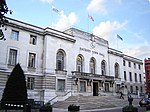German Hospital, Dalston
DalstonDefunct hospitals in LondonGrade II listed buildings in the London Borough of HackneyGrade II listed hospital buildingsHealth in the London Borough of Hackney

The German Hospital, Dalston, was a hospital in Dalston, East London.
Excerpt from the Wikipedia article German Hospital, Dalston (License: CC BY-SA 3.0, Authors, Images).German Hospital, Dalston
London Shacklewell (London Borough of Hackney)
Geographical coordinates (GPS) Address Nearby Places Show on map
Geographical coordinates (GPS)
| Latitude | Longitude |
|---|---|
| N 51.5467 ° | E -0.0668 ° |
Address
E8 1DJ London, Shacklewell (London Borough of Hackney)
England, United Kingdom
Open on Google Maps





